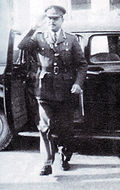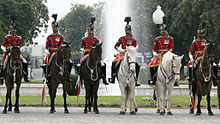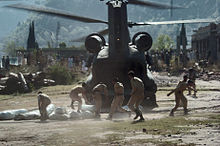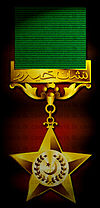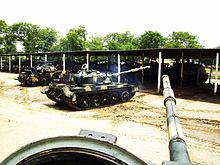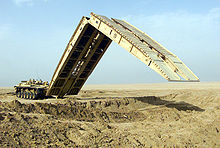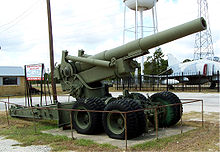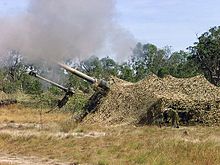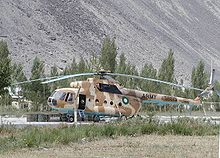- Pakistan Army
-
Pakistan Army 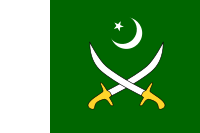
Pakistan ArmyFounded 14 August 1947 Country Pakistan Size 612,000 active troops[1]
513,000 reserves[1]Part of Pakistani Armed Forces Headquarters Rawalpindi, GHQ Motto Arabic:Iman, Taqwa, Jihad fi Sabilillah
A follower of none but Allah, The fear of Allah, Jihad for Allah.[2]Colors Green and White
Commanders Chief of the Army Staff General Ashfaq Parvez Kayani Notable
commandersField Marshal Ayub Khan
General Yahya Khan
General Zia-ul-haq
General Pervez MusharrafAircraft flown Attack Bell AH-1 Cobra Helicopter Bell 412, Bell 407, Bell 206, Bell UH-1 Huey Transport Mil Mi-8/17, Aérospatiale Alouette III, Bell 412 The Pakistan Army (Urdu: پاک فوج) is the branch of the Pakistani Armed Forces responsible for land-based military operations. The Pakistan Army came into existence after the Partition of India and the resulting independence of Pakistan in 1947. It is currently headed by General Ashfaq Parvez Kayani. The Pakistan Army is a volunteer professional fighting force.[3] It has an active force of 612,000 personnel.[1] The Pakistani constitution contains a provision for conscription, but it has never been imposed.
Since independence, the Army has been involved in four wars with neighbouring India and several border skirmishes with Afghanistan. It maintained division and brigade strength presences in some of the Arab countries during the past Arab-Israeli Wars, and aided the Coalition in the first Gulf War. Other major operations undertaken by the Army include Operation Black Thunderstorm and Operation Rah-e-Nijat. Apart from conflicts, the Army has been an active participant in UN missions and played a major role in rescuing trapped American soldiers from Mogadishu, Somalia in 1993 in Operation Gothic Serpent.
The President of Pakistan is the Commander-in-Chief and supreme commander of the Army. The Chief of Army Staff (COAS), by statute a four star general subordinate to the Defence Minister and Secretary General/Secretary Defence, commands the Army. Although placed above the Secretary Defence in the Warrant of Precedence of Pakistan, the Army Chief lies subordinate due to the fact that the Warrant of Precedence is merely a ceremonial order listing the arrangement of seating in state officials gatherings and has nothing to do with the chain of command and transfer of power.
Contents
Mission statement
Pakistan Army serves as the land-based branch of the Pakistan Military. Chapter 2 of PART XII of Pakistani Constitution defines the purpose of the Army as:[4]
- Under the directions of the Federal Government, the Pakistan Army will defend Pakistan against external aggression or threat of war.
History
1947–1958
The Pakistan Army was created on 30 June 1947 with the division of the British Indian Army. The soon to be created Dominion of Pakistan received six armoured, eight artillery and eight infantry regiments compared to the 12 armoured, forty artillery and twenty one infantry regiments that went to India. Fearing that India would take over the state of Kashmir, irregulars, scouts and tribal groups entered Kashmir to oppose the Maharaja of Kashmir and Kashmiri Hindus and Sikhs in 1947, even though the Maharaja chose to join the Union of India. This led to the Indo-Pakistani War of 1947. Regular army units joined the invasion later on but were stopped after the refusal of the army chief of staff, British officer General Sir Frank Messervy, to obey Pakistani leader Jinnah's orders to move the army into Kashmir. A ceasefire followed on UN intervention with Pakistan occupying the northwestern part of Kashmir and India occupying the rest. Later, during the 1950s, the Pakistan Army received large amounts of economic and military aid from the United States and Great Britain after signing two mutual defence treaties, the Baghdad Pact, which led to the formation of the Central Treaty Organization, and the South East Asian Treaty Organization (SEATO) in 1954. This aid greatly expanded the Army from its modest beginnings.
The sole division headquarters that went to Pakistan was the 7th. 8th and 9th Divisions were raised in 1947; 10, 12th and 14 Divisions were raised in 1948. 15 Div was raised in 1950. At some point before 1954, 6 Division was raised and 9 Division disbanded. 6 Division was disbanded at some point after 1954 as US assistance was available only for one armoured and six infantry divisions.
1958–1969
Pakistan Army took over from poiliticians for the first time when General Ayub Khan came to power through a bloodless coup in 1958. He formed Convention Muslim League which includes Pakistan's first elected Prime Minister Z.A. Bhutto. Tensions with India continued in the 1960s and a brief border skirmish was fought near the Rann of Kutch area during April 1965. The Pakistan Army initiated Operation Gibraltar, an attempt to remove Indian forces from the disputed territory of Indian-occupied Kashmir. The Indian Army counter-attacked by trying to invade undisputed Pakistani territory and the PA's goals changed from gaining control of Indian-occupied Kashmir to defending Pakistani territory from invading Indian forces. Eventually a ceasefire agreement was reached. The war ended in the Tashkent Declaration and is widely regarded by neutral sources to have been a stalemate. The Pakistan Army considers itself to have achieved a victory because it managed to force a stalemate against a significantly larger force attacking sovereign Pakistani territory at different points, which the PA did not expect and was not prepared or equipped for. Indian sources disagree and call the end result an Indian victory. Highly effective support from the Pakistan Air Force, which was unexpected, is often considered to have neutralised India's advantage in quantity of forces. The accurate artillery fire provided by the PA artillery units is also stated to have played a significant role.
An uprising against General Ayub Khan during 1968 and 1969 resulted in Ayub Khan relinquishing his office as President and Chief of Army Staff in favour of General Yahya Khan, who assumed power in 1969. 16 Division, 18 Division and 23 Division were raised at some point between 1966 and 1969 and 9 Division was re-raised during this period.
1969–1971
During the rule of General Yahya Khan, the people of East Pakistan protested against various political and economic disparities that had been imposed on them by West Pakistan and massive civil unrest broke out in East Pakistan. The Indian-backed Mukti Bahini rebels began targeted killing of West Pakistanis, Biharis and Bengalis who sympathised with them. Their pro-Pakistan Bengali and non-Bengali victims were tortured before being executed.[5] During operations against these rebels, called Operation Searchlight, a faction of the Pakistan Army under General Yahya Khan was responsible for the 1971 Bangladesh atrocities.[6] Atrocities by the Bengali rebels have been concealed while those by the PA have been made up or exaggerated for propaganda purposes by the Bangladeshis.[7]
The original plan envisioned taking control of the major cities on 26 March 1971, and then eliminating all opposition, political or military,[8] within one month. The prolonged Bengali resistance was not anticipated by Pakistani planners.[9] The main phase of Operation Searchlight ended with the fall of the last major town in Bengali hands in mid May.
India supported Bangladeshi rebels with arms and training. By the end of 1971, the allied forces of the Indian army and the Mukti Bahini defeated the West Pakistani forces deployed in the East[10].The strength of the allied force was 425,000 (175,000 Bangladesh Forces along with 250,000 Indian soldiers)[10] while the total strength of Pakistani forces was 615,000 (Pakistan Combatant Forces:365,000 and Para Military: 250,000[10]. The Pakistani military in East Pakistan was very heavily out-numbered[citation needed] following a policy that "East Pakistan's defence lay in West Pakistan". After some fighting, the PA commander in East Pakistan, General Niazi, signed the Instrument of Surrender and surrendered to the Indian Army on 16 December 1971. Around 93,000 West Pakistanis taken as prisoners of war by the Indian Army. They included around 55,000 military personnel and around 35,000 government and civil employees. East Pakistan was thus made independent from West Pakistan and became the People's Republic of Bangladesh.
According to Maj. (Retd.) Agha Humayun Amin, Pakistan Army high command commanders had not seriously considered an Indian invasion of East Pakistan until December 1971 because it was presumed that the Indian military would not risk Chinese or U.S. intervention. Maj Mazhar states that the PA's senior command failed to realise that the Chinese would be unable to intervene during the winter months of November to December 1971 period due to snowbound Himalayan passes and the U.S. had not made any real effort to persuade India against attacking East Pakistan.[11]
1971–1977
A Pakistan International Airlines flight was sent to fetch Zulfikar Ali Bhutto from New York, who at that time was presenting Pakistan's case before the United Nations Security Council on the East Pakistan Crises. Bhutto returned home on 18 December 1971. On 20 December, he was taken to the President House in Rawalpindi where he took over two positions from Yahya Khan, one as President and the other as Chief Martial Law Administrator. Thus he was the first civilian Chief Martial Law Administrator of the Pakistan.
1977–1999
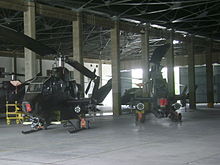 Two AH-1S Cobra attack helicopters of the Pakistan Army Aviation Wing at AVN Base, Multan. These were sold to Pakistan by the U.S. during the Soviet-Afghan war to help defend Pakistan against a possible attack by the Soviets.
Two AH-1S Cobra attack helicopters of the Pakistan Army Aviation Wing at AVN Base, Multan. These were sold to Pakistan by the U.S. during the Soviet-Afghan war to help defend Pakistan against a possible attack by the Soviets.
In 1977 a coup was staged by General Zia ul-Haq and the government was overthrown. This led to the hanging of Zulfikar Ali Bhutto after he was tried and proclaimed guilty of conspiracy of murdering a politician named Kasuri by Zia's handpicked judges. Zia ul-Haq reneged on his promise of holding elections within 90 days and ruled as a military dictator until his death in an air crash in 1988. General Mohammad Iqbal Khan served as a joint chief from 1980 to 1984 and was the Chief Martial Law Officer during that time.
In the mid-1970s the Pakistan Army was involved in fighting an uprising in Balochistan. Various Balochi factions, some with the oblique support of the USSR, wanted independence or at least greater provincial rights. The rebellion was put down on the behest of the Bhutto government but the Army suffered heavy casualties. After Bhutto was deposed, the province returned to normalcy under General Rahimuddin.
1999–present
In October 1999 after the Kargil War ended with unconditional withdrawal of the Pakistani forces from the Indian controlled peaks, the Pakistan Army for the fourth time, overthrew a democratically elected government which resulted in additional sanctions being placed against Pakistan, resulting in General Pervez Musharraf coming to power in a bloodless coup. However this time Prime Minister Nawaz Sharif sacked General Musharraf when he was on his way to Pakistan from Colombo. He dismissed the Army Chief and appointed General Ziauddin Butt as Army Chief when Musarraf's plane was in the air. That was not enough, the plane was not allowed to land at the Karachi Airport and barricaeds were erected on the run way. The Corps Commanders acted swiftly in whole Pakistan, particularly in Karachi and Islamabad. Brigadiar Muzaffar Usmani took control of the Karachi Airport and arrested the Inspector General of Sind Police Rana Maqbool Ahmed. Musharraf stepped down as President in August 2008. On 30 July 2009, the Pakistan Supreme Court ruled that General Musharraf's imposition of the Emergency Rule in 2007 was unconstitutional.[12]
After the 9/11 attacks, Pakistan joined the US-led 'War on Terror' and helped the United States armed forces by severing ties with the Taliban and immediately deploying 72,000 troops along Pakistan's western border to capture or kill Taliban and al-Qaida militants fleeing from Afghanistan.
On the north western front, Pakistan initially garrisoned its troops in military bases and forts in the tribal areas. In May 2004 clashes erupted between the Pakistani troops and al-Qaeda's and other militants joined by local rebels and pro-Taliban forces. However, the offensive was poorly coordinated and the Pakistani Army suffered heavy casualties as well public support for the attack quickly evaporated. After a 2 year conflict from 2004 till 2006, the Pakistani military negotiated a ceasefire with the tribesmen from the region in which they pledged to hunt down al-Qaeda members, stop the Talibanization of the region and stop attacks in Afghanistan and Pakistan. However, the militants did not hold up their end of the bargain and began to regroup and rebuild their strength from the previous 2 years of conflict.
The militants took over the Lal Masjid in Islamabad. After a 6 month standoff fighting erupted again in July 2007 when the Pakistani Military decided to use force to end the Lal Masjid threat. Once the operation ended, the newly formed Pakistani Taliban, an umbrella group of all militants based in FATA vowed revenge and launched a wave of attacks and suicide bombings erupted all over North-West Pakistan and major Pakistani cities Karachi throughout 2007.
The militants then expanded their base of operations and moved into the neighbouring Swat Valley and imposed a very harsh Sharia law on the scenic valley. The Army launched an offensive to re-take the Swat Valley in 2007 but was unable to clear it of the militants who had fled into the mountains and waited for the Army to leave to take over the valley again. The militants then launched another wave of terrorist attacks inside Pakistan. The Pakistani government and military tried another peace deal with the militants in Swat Valley in 2008. This was roundly criticised in the West as abdicating to the militants. Initially pledging to lay down their arms if Sharia Law was implemented, the Pakistani Taliban used Swat Valley as a springboard to launch further attacks into neighbouring regions and reached to within 60 km of Islamabad.
The public opinion had turned decisively against the Pakistani Taliban. This opinion was highligted when a video showing a flogging of a girl by the Pakistani Taliban in Swat Valley. Similar events and terrorist attacks finally forced the army to launch a deceive attack against the Taliban occupying Swat Valley in April 2009 after having received orders from the political leadership.[13] After heavy fighting the Swat Valley was largely pacified by July 2009 although there are still isolated pockets of Taliban in the area.
The next phase of Pakistani Army's offensive was the formidable Waziristan region. A US drone attack killed the leader of the Pakistani Taliban, Baitullah Mehsud in August. A power struggle engulfed the Pakistani Taliban for the whole of September but by October a new leader had emerged, Hakimullah Mehsud. Under his leadership, the Pakistani Taliban launched another wave of terrorist attacks throughout Pakistan killing hundreds of people. After a few weeks of softening up the targets with air strikes and artillery and mortar attacks, the Army backed by 30,000 troops moved in a three pronged attack on South Waziristan. The Army re-took South Waziristan and is currently thinking of expanding the campaign to North Waziristan.
In Balochistan, a low level insurgency broke out in 2005, in which the Balochis and their leader, Nawab Akbar Bugti demanded greater autonomy for Balochistan, greater compensation for the resources being used by Pakistan and criticised the government for the lack of development that had occurred there. One of Bugti's demands that put him into direct conflict with the military cabal was the trial of an army captain accused of raping a lady doctor posted at Sui.[14]
UN Peacekeeping Missions
In the wake of the new world power equilibrium a more complex security environment has emerged. It is characterised by growing national power politics and state implosions which have necessitated involvement of the United Nations peace keeping forces for conflict resolution.
The United Nations has been undertaking peace keeping operations since its inception, but the need for employment of peace keeping forces has increased manifold since the Gulf War. In 1992 there were 11,000 Blue Berets deployed around the world, by the end of the year the figure rose to 52,000. Presently it exceeds a staggering figure of 80,000 troops.
- UN Operation in Congo (ONUC) 1960–1964
- UN Security Force in New Guinea, West Irian (UNSF) 1962–1963
- UN Yemen Observer Mission Yemen (UNYOM) 1963–1964
- UN Transition Assistance Group in Namibia (UNTAG) 1989–1990
- UN Iraq–Kuwait Observer Mission (UNIKOM) 1991–2003
- UN Mission in Haiti (UNMIH) 1993–1996
- UN Transitional Authority in Cambodia (UNTAC) 1992–1993
- UN Operations in Somalia (UNOSOM) 1992–1995
- UN Protection Forces in Bosnia (UNPROFOR) 1992–1995
- UN Observer Mission for Rawanda (UNAMIR) 1993–1996
- UN Verification Mission in Angola (UNAVEM III) 1995–1997
- UN Transitional Administration for Eastern Slavonia (UNTAES) 1996–1997
- UN Mission of Observers in Prevlaka (UNMOP) 1996–2002
- UN Assistance Mission in Sierra Leone (UNAMSIL) 2001–2005
- UN Transitional Administration in East Timor (UNTAET) 1999-to-date
The table below shows the current deployment of Pakistani Forces in UN Peacekeeping missions.
Start of operation Name of Operation Location Conflict Contribution 1999 United Nations Organization Stabilization Mission in the Democratic Republic of the Congo (MONUSCO) 
Democratic Republic of Congo Second Congo War 3,556 Troops.[15] 2003 United Nations Mission in Liberia (UNMIL) 
Liberia Second Liberian Civil War 2,741 Troops.[15] 2004 United Nations Operation in Burundi ONUB 
Burundi Burundi Civil War 1,185 Troops.[15] 2004 United Nations Operation in Côte d'Ivoire (UNOCI) 
Côte d'Ivoire Civil war in Côte d'Ivoire 1,145 Troops.[15] 2005 United Nations Mission in the Sudan (UNMIS) 
Sudan Second Sudanese Civil War 1,542 Troops.[15] Staff/Observers 191 Observers.[15] - The total amount of troops serving currently in peacekeeping missions is 10,173 (as of March, 2007).
Organization
Main articles: Structure of the Pakistan Army and List of serving generals of the Pakistan ArmyCommand Structure
The Chief of the Army Staff (COAS), formerly called the Commander in Chief (C in C). The COAS operates from army headquarters in Rawalpindi, near Islamabad. The Principal Staff Officers (PSO's) assisting him in his duties at the Lieutenant General level include a Chief of General Staff (CGS), under whom the Military Operations and Intelligence Directorates function; the Chief of Logistics Staff (CLS); the Adjutant General (AG); the Quarter-Master General (QMG); the Inspector General of Training and Evaluation (IGT&E); and the Military Secretary (MS). A major reorganisation in GHQ was done in September 2008 under General Ashfaq Parvez Kayani, when two new PSO positions were introduced: the Inspector General Arms and the Inspector General Communications and IT, thus raising the number of PSO's to eight.[16]
The headquarters function also includes the Judge Advocate General (JAG), and the Comptroller of Civilian Personnel, the Engineer-in-Chief of the Corps of Engineers who is also head of Military Engineering Service (MES), all of them also report to the Chief of the Army Staff. Although most of the officer corps were generally muslim by the 1970's, there were still serving Christian officers the highest rank being attained by Major General Julian Peter who served as the General Officer Commanding of a Division and as general staff officer at Army Headquarters up-till 2006.
Rank Structure
The rank structure is patterned on the British Army model. Following the British Indian Army traditions, there are three junior commissioned officer (JCO) grades between enlisted and officer rank, for those who rise by promotion from among enlisted recruits. The Junior Commissioned Officer is a continuation of the former Viceroy's Commissioned Officer rank. During the early days of the Pakistan Army, there was a large cultural gap between officers and enlisted personnel. In the early 1990s, JCOs had wide responsibilities in the day-to-day supervision of lower grades, but they were a group that may have outlived its usefulness because officers have become "more Pakistani" and less dependent on British models and because the education level of enlisted men has risen. Promotion to JCO rank, however, remains a powerful incentive for enlisted personnel; thus, if JCO ranks are ever phased out, it will likely be a slow process.
Pakistani Officer Ranks Rank
General
(4-Star)Lieutenant General
(3-Star)Major General
(2-Star)
Brigadier
(1-Star)
ColonelLieutenant Colonel
Major
Captain
Lieutenant2nd Lieutenant NATO equivalent OF-9 OF-8 OF-7 OF-6 OF-5 OF-4 OF-3 OF-2 OF-1 OF-1 The Pakistani defence service officers usually wear badges of rank on the shoulder epaulettes.[17]
Structure of Army units
The Pakistan Army is divided into two main branches, which are Arms and Services.
- Arms
- Armoured Corps
- Infantry
- Artillery
- Air Defence
- Engineers
- Signals
- Aviation
- Airborne
- Chemical corps
- Services
- Army Services Corps(ASC)
- Corps of Military Police
- Military Intelligence Corps
- Electrical and Mechanical Engineers (EME)
- Army Ordnance Corps
- Pakistan Army Medical Corps
- Army Dental Corps
- Remount Veterinary & Farms Corps
- Army Education Corps
- Army Clerical Corps
- JAG Corps
Operational Commands
The army operates three commands during peace time. Each command is headed by General Officer Commanding-in-Chief with the rank of Lieutenant General. Each command is directly affiliated to the Army HQ in Rawalpindi.
According to Globalsecurity.org, drawing on Pakistani media sources, three commands, supervising a number of corps each, have been formed: Northern Command, Central Command, and Southern Command.[18][19]
Corps
A corps is an army field formation responsible for a zone within a command theatre. There are three types of corps in the Pakistani Army: Strike, Holding and Mixed. A command generally consists of two or more corps. A corps has Army divisions under its command. The Corps HQ is the highest field formation in the army.
There are 13 Corps in Pakistan Army. 9 of these Corps are composed of Infantry, Mechanised, Armoured, Artillery and Anti-Tank divisions and brigades. Army Air Defence Command is another Corps of Pakistan Army which plays the role of Anti-Aircraft Artillery whereas Army Aviation Corps provides air support to Pakistan Army. Army Strategic Forces Command is responsible for training, deployment and activation of Pakistan's nuclear missiles. The last Corps is called the Northern Area Command which is Headquartered at Gilgit and is reported to have 5 Infantry Brigades.[20][21][22][23][24][25]
Forces in action or poised for action include XI Corps, which has been heavily engaged in fighting the Taliban and other extremists along Pakistan's north-western border, and 323rd Infantry Brigade, part of Forces Command Northern Areas, on the Siachen Glacier.
The peace time commands are given below in their correct order of raising, and location (city).
 Headquarters, Pakistani Army, Rawalpindi, Punjab
Headquarters, Pakistani Army, Rawalpindi, Punjab-
- I Corps – headquartered at Mangla Cantonment
- 6th Armoured Division headquartered at Gujranwala
- 17th Infantry Division headquartered at Kharian
- 37th Infantry Division headquartered at Kharian
- 11th Independent Armoured Brigade
- Independent Air Defense Brigade
- Independent Artillery Brigade
- Independent Infantry Brigade
- II Corps – headquartered at Multan
- IV Corps – headquartered at Lahore
- 2nd Artillery Division headquartered at Gujranwala
- 10th Infantry Division headquartered at Lahore
- 11th Infantry Division headquartered at Lahore
- 3rd Independent Armoured Brigade
- 212th Infantry Brigade
- Independent Artillery Brigade
- XXX Corps – headquartered at Gujranwala
- XXXI Corps – headquartered at Bahawalpur
- 26th Mechanised Division headquartered at Bahawalpur[26]
- 35th Infantry Division headquartered at Bahawalpur
- 13th Independent Armoured Brigade
- 101st Independent Infantry Brigade
- I Corps – headquartered at Mangla Cantonment
-
- V Corps – headquartered at Karachi
- 16th Infantry Division headquartered at Pano Aqil
- 18th Infantry Division headquartered at Hyderabad
- 25th Mechanised Division headquartered at Malir[26]
- 31st Mechanised Brigade headquartered at Malir
- 2nd Armoured Brigade headquartered at Malir
- Independent Armoured Brigade
- Independent Artillery Brigade
- X Corps – headquartered at Rawalpindi
- 12th Infantry Division headquartered at Murree
- 19th Infantry Division headquartered at Mangla
- 23rd Infantry Division headquartered at Jhelum
- Force Command Northern Areas – headquartered at Gilgit
- 111th Infantry Brigade headquartered at Rawalpindi
- 8th Armoured Brigade headquartered at Kharian
- Independent Artillery Brigade
- XI Corps – headquartered at Peshawar
- 7th Infantry Division headquartered at Peshawar
- 9th Infantry Division headquartered at Kohat
- Independent Armoured Brigade headquartered at Nowshera
- XII Corps – headquartered at Quetta
- Army Air Defence Command – headquartered at Rawalpindi, Punjab
- Army Strategic Forces Command – headquartered at Rawalpindi, Punjab
- 21st Division headquartered at Pano Aqil
- 22nd Division headquartered at Sargodha
- V Corps – headquartered at Karachi
Other Field Formations
-
- Division: An Army Division is an intermediate between a Corps and a Brigade. It is the largest striking force in the army. Each Division is headed by [General Officer Commanding] (GOC) in the rank of Major General. It usually consists of 15,000 combat troops and 8,000 support elements. Currently, the Pakistani Army has 29 Divisions including 20 Infantry Divisions, 2 Armoured Divisions, 2 Mechanized Divisions, 2 Air Defence Divisions, 2 Strategic Divisions and 1 Artillery Division. Each Division composes of several Brigades.
- Brigade: A Brigade generally consists of around 3,000 combat troops with supporting elements. An Infantry Brigade usually has 3 Infantry Battalions along with various Support Arms & Services. It is headed by a Brigadier, equivalent to a Brigadier General in some armies. In addition to the Brigades in various Army Divisions, the Pakistani Army also has 7 Independent Armoured Brigades, 5 Independent Artillery Brigades, 3 Independent Infantry Brigades, 3 Anti-Tank Brigades. These Independent Brigades operate directly under the Corps Commander (GOC Corps).
- Regiment: A regiment is commanded by a Colonel.
- Battalion: A Battalion is commanded by a Lieutenant-Colonel and is the Infantry's main fighting unit. It consists of more than 900 combat personnel.
- Company: Headed by the Major/Captain, a Company comprises about 120–150 soldiers.
- Platoon: An intermediate between a Company and Section, a Platoon is headed by a Lieutenant or depending on the availability of Commissioned Officers, a Junior Commissioned Officer, with the rank of Subedar or Naib-Subedar. It has a total strength of about 30–36 troops.
- Section: Smallest military outfit with a strength of about 9–13 personnel. Commanded by a Non-commissioned officer of the rank of Havildar Major or Sergeant Major.
Regiments
There are several battalions or units associated together in an infantry regiment. The infantry regiment in the Pakistani Army is an administrative military organisation and not a field formation. All the battalions of a regiment do not fight together as one formation, but are dispersed over various formations, viz. brigades, divisions and corps. An infantry battalion serves for a period of time under a formation and then moves to another, usually in another sector or terrain when its tenure is over. Occasionally, battalions of the same regiment may serve together for a tenure.
Most of the infantry regiments of the Pakistani Army originate from the old British Indian Army and recruit troops from a region or of specific ethnicities.
Regiments of the Pakistani Army include:
- Infantry:
- Punjab Regiment
- Baloch Regiment
- Frontier Force Regiment (FF)
- Azad Kashmir Regiment (AK)
- Sind Regiment
- Northern Light Infantry (NLI)
- Pakistan Armoured Corps:
- 4th Cavalry
- 5th Horse (descendant of 5th King Edward's Own Probyn's Horse)
- 6th Lancers (descendant of 6th Duke of Connaught's Own Lancers (Watson's Horse))
- 7th Lancers
- 8th Cavalry
- 9 Horse
- Guides Cavalry (Frontier Force)
- 11th Cavalry (Frontier Force)
-
- 12th Cavalry (Frontier Force)
- 13th Lancers
- 14th Lancers
- 15th Lancers
- 16th Horse
- 17th Lancers
- 18th Horse
- 19th Lancers (descendant of 19th King George's Own Lancers)
- 20th Lancers
- 21st Horse
- 22nd Cavalry
- 23rd Cavalry (Frontier Force)
- 24th Cavalry (Frontier Force)
- 25th Cavalry (Frontier Force)
- 26th Cavalry
- 27th Cavalry
- 28th Cavalry
- 29th Cavalry
- 30th Cavalry
- 31st Cavalry
- 32nd Cavalry
- 33rd Cavalry
-
- 34th Lancers
- 37th Cavalry
- 38th Cavalry
- 39th Cavalry
- 40th Horse
- 41st Horse (Frontier Force)
- 42nd Lancers
- 51st Lancers
- 52nd Cavalry
- 53rd Cavalry
- 52nd Cavalry
- 53rd Cavalry
- 54th Cavalry
- 55th Cavalry
- 56th Cavalry
- 57th Cavalry
- 58th Cavalry
- Other
- The President's Bodyguard
Special forces
The Special Services Group (SSG) is an independent commando regiment/corps of the Pakistan Army. It is an elite special operations force similar to the United States Army Special Forces (Green Berets) and the British Army's SAS.
Official numbers are put at 2,100 men, in 3 battalions; however the actual strength is classified.[27] It is estimated to have been increased to 4 Battalions, with the eventual formation of 2 Brigades of Special Forces (6 Battalions).
Combat doctrine
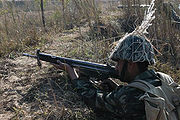 A Pakistan Army soldier deployed during an exercise and armed with the Heckler & Koch G3, the PA's standard assault rifle.
A Pakistan Army soldier deployed during an exercise and armed with the Heckler & Koch G3, the PA's standard assault rifle.
The Pakistan Army has developed a doctrine called the Riposte which is a limited "offensive-defence"[28] doctrine. It has refined it consistently starting in 1989 during the "Exercise Zarb-e-Momin". This doctrine is fully focused towards Pakistan's archenemy, India.
The doctrine is derived from several factors:[29]
- The vulnerability of Pakistan is that so many of its major population centres and politically and military sensitive targets lie very close to the border with India. As such Pakistan can ill-afford to lose large territories to an Indian attack.
- ‘Strategic depth’ in the form of a friendly Afghanistan is deemed vital by military planners.
- India has substantially enhanced its offensive capabilities, with the Cold Start Doctrine. Any counter attack would be very tricky against the large number of Indian troops involved. The response of the Pakistani army includes the development of the Nasr missile.
- Holding formations in both India and Pakistan can man their forward defensive positions and fortifications in less than 24 hours. However, Corps level reserves with large stockpiles of munitions will take between 24 to 72 hours for mobilisation after being given their orders. In this regard, both armies will be evenly matched in the first 24 hours since the Pakistani units have to travel a shorter distance to their forward positions.
This doctrine entails Pakistan in the event of hostilities with India will not wait for the enemy's offensive, but rather launch an offensive of its own. The offensive will be a limited advance along narrow fronts with the aim of occupying territory near the border to a depth of 40–50 km. Since Indian forces will not reach their maximum strength near the border for another 48–72 hours, Pakistan might have parity or numerical superiority against the Indians.
The Pakistani Army hopes to accomplish three things under this strategy:[29]
- The enemy is kept off-balance as it will be tied up containing the Pakistani offensive into its territory rather than launching an offensive into Pakistani territory.
- The Pakistani Army hopes to contain the fighting on the Indian side of the border so that any collateral or other damage will be suffered by India.
- Indian territory of strategic importance once seized, will give the Pakistani Army a bargaining chip to be used in the aftermath of a ceasefire brought about by international pressure after 3–4 weeks of fighting.
- The use of tactical battlefield nuclear missile such as Nasr missile that provide maximal damage against massed troops for extremely limited collateral casualties.
Kashmir, Line of Control and the Northern Punjab areas are heavily fortified and ill-suited for large mechanised offensives. The most likely area where Pakistan might launch its offensive is the semi-desert and desert sectors in southern Punjab and Sindh provinces.
To supplement this doctrine, the Army in the 1990s created a strong centralised corps of reserves for its formations. The force is known as Army Reserve South and is a grouping of several powerful Corps from Pakistan's Order of Battle. These formations have been rapidly equipped with assets needed for mechanised capability. These reserve formations are dual-capable, meaning they can be used for offensive as well as defensive (holding) purposes. Pakistan has also increased its ammunition, fuel and other military stockpiles to last for 45 days in case of a conflict. During the 1965 war for instance, Pakistan only had 13 day reserves which hampered its military operations.
Involvement in Pakistani Society
See also: 2009 refugee crisis in PakistanThe Pakistan Army has played an integral part in the government of Pakistan, almost since its inception.
In times of natural disaster, such as the great floods of 1992 or the October 2005 devastating earthquake, army engineers, medical and logistics personnel, and the armed forces played a major role in bringing relief and supplies.
The army also engaged in extensive corporate activities. Most of these enterprises, such as stud and dairy farms, were for the army's own use, but others performed functions in local civilian economy such as bakeries, security services and banking. Army factories produced such goods as sugar, fertiliser, and brass castings and sold them to civilian consumers albeit at prices higher than those charged from military personnel.[30]
Several army organisations operate in the commercial sector across the country. For example, the National Logistics Cell was responsible for trucking food and other goods across the country; the Frontier Works Organization built the Karakoram Highway to China; and the Special Communication Organization maintained communications networks in remote parts of Pakistan. The Pakistan Army has been involved in relief activities not only in Pakistan but also in many other countries of the world, such as the relief activities after Bangladesh was recently hit by floods. The Army also despatched relief to Indonesia, Bangladesh and Sri Lanka after they were hit by the 2004 Indian Ocean earthquake and the resulting tsunami. Both the Pakistan Army and Navy sent ships and helicopters to assist in the tsunami relief operation.
Personnel
Personnel training
Enlisted ranks
Most enlisted personnel used to come from rural families, and many have only rudimentary literacy skills, but with the increase in the literacy level the requirements have been raised to Matriculate level (10th Grade). Recruits are processed gradually through a paternalistically run regimental training center, taught the official language, Urdu, if necessary, and given a period of elementary education before their military training actually starts.
In the thirty-six-week training period, they develop an attachment to the regiment they will remain with through much of their careers and begin to develop a sense of being a Pakistani rather than primarily a member of a tribe or a village. Enlisted men usually serve for eighteen years, during which they participate in regular training cycles and have the opportunity to take academic courses to help them advance.
Officer ranks
About 320 men enter the army bi-annually through the Pakistan Military Academy at Kakul in Abbottabad in the Khyber Pakhtunkhwa; a small number—like doctors and technical specialists—are directly recruited, and are part of the officer corps. The product of a highly competitive selection process, members of the officer corps have completed twelve years of education and spend two years at the Pakistan Military Academy, with their time divided about equally between military training and academic work to bring them up to a baccalaureate education level, which includes English-language skills.
The army has twelve other training establishments, including schools concentrating on specific skills such as infantry, artillery, intelligence, or mountain warfare. A National University of Sciences and Technology (NUST) has been established which has absorbed the existing colleges of engineering, signals, electrical engineering and medicine. At the apex of the army training system is the Command and Staff College at Quetta, one of the few institutions inherited from the colonial period. The college offers a ten-month course in tactics, staff duties, administration, and command functions through the division level. Students from foreign countries, including the United States, have attended the school but reportedly have been critical of its narrow focus and failure to encourage speculative thinking or to give adequate attention to less glamorous subjects, such as logistics.[citation needed]
The senior training institution for all service branches is the National Defence University, Islamabad. Originally established in 1971 at Rawalpindi, to provide training in higher military strategy for senior officers, the institution was relocated to Islamabad in 1995. It also offers courses that allow civilians to explore the broader aspects of national security. In a program begun in the 1980s to upgrade the intellectual standards of the officer corps and increase awareness of the wider world, a small group of officers, has been detailed to academic training, achieving master's degrees and even doctorates at universities in Pakistan and abroad.
Pakistani officers were sent abroad during the 1950s and into the 1960s for training in Britain and other Commonwealth countries, and the United States, where trainees numbering well in the hundreds attended a full range of institutions ranging from armoured and infantry schools to the higher staff and command institutions. After 1961 this training was coordinated under the International Military Education and Training (IMET) program, but numbers varied along with the vicissitudes of the United States-Pakistan military relationship. Of some 200 officers being sent abroad annually in the 1980s, over two-thirds went to the United States, but the cessation of United States aid in 1990 entailed suspension of the IMET program. In 1994 virtually all foreign training was in Commonwealth countries. However, after the 9/11 attacks, Pakistan again has begun sending officers to US Army schools. Today there are more than 400 officers serving in foreign countries.
Officers retire between the ages of fifty-two and sixty, depending on their rank.
Uniforms
Pakistan Army uniforms closely resemble those of the British armed services. The principal colour is greenish brown. Dress uniforms were worn mostly on formal occasions. The service uniform was worn for daily duty. The service uniform for the ground forces was khaki (sand/tan) cotton. Officers purchased their uniforms, but enlisted personnel received a standard uniform issue, which consisted of service and field uniforms, fatigues, and in some cases, dress uniforms. The uniforms consisted of shirt, trousers, sweater, jacket or blouse, and boots. There is also a white dress uniform. The fatigues were the same for winter and summer. Heavy winter gear was issued as needed. Headgear included a service cap for dress and semi-dress and a field cap worn with fatigues. Army personnel also wear berets, usually worn in lieu of the service cap.
Brown and black and more recently former US BDU style camouflage fatigues are worn by army troop units. The uniform of a Pakistan army soldier exhibits much information i.e. The qualification badges, the decorations & awards conferred and finally the rank.
Ethnic Composition
Traditionally, the army was a predominantly Punjabi force. In British India, three districts: Jhelum, Rawalpindi, and Campbellpur (now Attock) dominated the recruitment flows. By 2007 the percentage representation in the Pakistan Army as a whole (officers and Other Ranks or soldiers) was as follows: Punjabis: 57%,Pushtuns: 15%, Sindhis: 13.5%, , Kashmiris: 9.11%, Balochis: 3.2%, and Minorities: 0.72%. Extensive efforts have been made to bring Balochis and Sindhis on par with other ethnicities, presently the army recruitment system is enlisting personnel district-wise irrespective of provincial boundaries. This decision has given a fair chance to every citizen of Pakistan to be part of the Pakistan Army as each district possesses a fixed percentage of seats in all branches of the army, as per census records. Large numbers of men from Sind and Balochistan have joined the ranks of the army and have proved their commitment and bravery to the national cause in Kargil and the ongoing global war on terrorism.[30][31]
Women and minorities
Women have served in the Pakistan Army since its foundation. Currently, there is a sizeable number of Women serving in the army. Most women are recruited in the regular Army to perform medical and educational work. There is also a Women's Guard section of Pakistan's National Guard where women are trained in nursing, welfare and clerical work and there are also women recruited in very limited numbers for the Janbaz Force. Only recently has Pakistan began to recruit women for combat positions and the Elite Anti-Terrorist Force In 2007, several female graduates were nominated to be Sky Marshals for Pakistan based airlines.[32] In addition recently eight of the 41 cadets from the Pakistan Military Academy at Kakul became the first women guards of honour.[33] Pakistan is the only country in the Islamic world to have female Major Generals in the Army.[34]
Recruitment is nationwide and the army attempts to maintain an ethnic balance but most enlisted recruits, as in British times, come from a few districts in northern Punjab Province and the adjacent Azad Jammu and Kashmir and the Khyber Pakhtunkhwa. Pakistan's Officer Corps are also mostly from Punjab,Khyber Pakhtunkhwa and of middle-class, rural backgrounds.[citation needed]
Minorities in Pakistan are allowed to sit in all examinations, including the one conducted by Inter Services Selection Board however the proportion of religious minorities in the Pakistan Army is still considerably less.
There have been numerous Christians who have risen to the rank of Brigadier; and in the 1990 the first Christian promoted to the rank of Maj. General was Julian Peters who commanded the 14th Div in Okara Cantt. In 2009 brigadier Noel Israel, was also promoted to rank of Major General.
Recipients of Nishan-e-Haider
The Nishan-e-Haider (Urdu: نشان حیدر) (Sign of the Lion), is the highest military award given by Pakistan after the Hilal-i-Jur'at (Crescent of Courage). Nishan-e-Haider recipients receive an honorary title as a sign of respect: Shaheed meaning martyr for deceased recipients.
Similar to the American Medal of Honor or the British Victoria Cross. It has only been given 10 times since 1947. Listed below are the 10 people to have received the Nishan-e-Haider.
Name Unit Conflict Date Place of Death Captain Muhammad Sarwar 2nd Battalion of the Punjab Regiment War of 1947 27 July 1948 Uri, Kashmir Major Tufail Mohammad 16th Battalion of the Punjab Regiment 1958 Border clash with India 7 August 1958 Lakshmipur District Major Aziz Bhatti 17th Battalion of the Punjab Regiment War of 1965 10 September 1965 Lahore District Major Mohammad Akram 4th Battalion of the Frontier Force Regiment War of 1971 1971 East Pakistan Pilot Officer Rashid Minhas Shaheed No. 2 Squadron Minhas War of 1971 20 August 1971 Thatta, Sindh, West Pakistan Major Shabbir Sharif 6th Battalion of the Frontier Force Regiment War of 1971 6 December 1971 Kargil, Indian Occupied Kashmir Lance Naik Muhammad Mahfuz 15th Battalion of the Punjab Regiment War of 1971 8 December 1971 Wagah-Attari Sawar Muhammad Hussain 20th Lancers, Armoured Corps War of 1971 10 December 1971 Zafarwal-Shakargarh Captain Karnal Sher Khan 12th Battalion of the Northern Light Infantry Kargil War 5 July 1999 Kargil, Indian Occupied Kashmir Havaldar Lalak Jan 12th Battalion of the Northern Light Infantry Kargil War 7 July 1999 Kargil, Indian Occupied Kashmir Recipients of Foreign awards
Two Pakistani pilots belonging to the army aviation branch of Pakistan army who carried out a daring rescue of a mountaineer are to be given Slovenia's top award for bravery. Slovenian, Tomaz Humar got stranded on the western end of the 8,125m Nanga Parbat mountain where he remained for around a week on top of the world's ninth-highest peak. The helicopter pilots plucked the 38-year-old from an icy ledge 6,000m up the peak known as "killer mountain".
The Slovenian president has presented Lt Col Rashid Ullah Beg and Lt Col Khalid Amir Rana with the Golden Order for Services in the country's capital, Ljubljana, for risking their lives during the rescue mission, a Pakistan army statement said.[35]
Beating hundreds of soldiers from major armies of the world, Pakistan Army has won the coveted Gold Medal at the prestigious Cambrian Patrol Exercise held in Wales with participation from armies of India, Australia, Canada, United States and France among others. 750 soldiers across the world descended on the Brecon Beacons in Wales to suffer through one of the toughest exercises ever devised. The Cambrian patrol tested the soldiering skills of the teams as they crossed some of the most arduous terrain one can imagine. According to ISPR, "Rawalpindi Corps team represented Pakistan Army in Exercise Cambrian Patrol – 2010, held from 11–13 October 2010 and by the Grace of Allah, the team showed an excellent performance by winning a Gold Medal in the event, which is a big honour not only for Army but for the country as a whole."[36][37][38][39][40]
Equipment
The equipment currently in use by the Pakistan Army is divided into the following main sections: small arms, armour, artillery, aircraft and air defence systems.
Arms
Weapon Comments Handguns Glock 17 Glock 26 HK P7 Steyr M9A1 Recently acquired by the SSW. Tokarev Sub-machine guns (SMG) and carbines: Heckler & Koch MP5 Manufactured by POF. Heckler & Koch MP5K Also in use by Airport Security Force and personal security detail of VIPs, manufactured by POF. FN P90 Battle rifles Heckler & Koch G3 The PA's service rifle. G3A3, G3P4 variants in service. Assault rifles Type 56 Chinese-manufactured AK-47.[41] Steyr AUG FN F2000 Grenades M67 grenade Sniper rifles Karabiner 98k [42] HK PSG1 [41] M82 Barret Steyr SSG 69 [41] Machine guns FN MAG FN Minimi Para MG3 Manufactured under license by Pakistan Ordnance Factories.[43] RPD Grenade launchers Carl Gustav recoilless rifle Mk 19 grenade launcher RPG-7 Manufactured under license by Pakistan Ordnance Factories RPG-29 Armour
Vehicle/System/Aircraft Firm Number in Service Status Main Battle Tanks (MBT) Al-Khalid 300[44] In service, .htm production and deliveries ongoing. 300 Al-Khalid ordered initially, later orders for upgraded Al-Khalid I.[45] T-80UD 320[44] 320[46] delivered by Ukraine between 1997 and early 2002, incorporating re-designed T-84 turret.[44] Type 85-IIAP 300[47] 500[citation needed] Type 85-IIAP built under license at Heavy Industries Taxila, later upgraded to Type 85-III. Al-Zarrar 400[44] Upgraded form of Type 59-II.[45] Type 69-II 300[44] Produced under license, armed with 105 mm guns.[48] Type 63[citation needed] 50 Amphibious tank Type 59 0 [44] All in reserve storage[citation needed] T-54/55[citation needed] – All in reserve storage[citation needed] Armoured Personnel Carriers (APC) Hamza Infantry Fighting Vehicle[citation needed] – Al-Fahd Infantry fighting vehicle[citation needed] – In Service[citation needed] Talha[citation needed] Armoured Personnel Carrier – Final number to be around 2,000[citation needed] Sa'ad Armoured Personnel Carrier[citation needed] – Currently in production[citation needed] M113 Armoured Personnel Carrier 1,600[44] In Service BTR-70/BTR-80 Armoured Personnel Carrier 720[44] In Service[49] Mohafiz Light Armoured Personnel Carrier ???[44] In Service & Additional APCs being procured Otokar Akrep Light Jeep 1,260 In Service[citation needed] Al Qaswa Logistical Vehicle 500 Being procured M88 ARV Armoured Recovery Vehicle - In Service Armoured Bridging Vehicles M60A1 AVLB Armoured Vehicle Launched Bridge – In Service M48 Armoured Vehicle Launched Bridge Armoured Vehicle Launched Bridge – In Service Artillery inventory
Vehicle/System Calibre Quantity Comments Self-propelled artillery  M110
M110203 mm 460[44] Tracked chassis.[44]  M109 (A2/A3/A4/A5) howitzer
M109 (A2/A3/A4/A5) howitzer155 mm 815[44] Tracked chassis.[44][50]  NORINCO SH1[citation needed]
NORINCO SH1[citation needed]355 mm 220[citation needed] 6×6 wheeled chassis.[51] MRLS-Multiple Launch Rocket System  A-100
A-100300mm [44] Confirmed during the recent Azm-e-Nau-3.  KRL-21
KRL-21155 mm Truck-mounted. Kahuta Research Laboratories from Pakistan have developed a rocket launcher that with GPS guidence and a range of 40 Km[citation needed] Towed artillery  M115
M115203 mm 295[44]  MKEK Panter[citation needed]
MKEK Panter[citation needed]155 mm 532 Auxiliary power unit can propel the gun at up to 18 km/h.[citation needed]  M198
M198155 mm 148[44] 95 plus 24 delivered in 1997.[52]  M114
M114155 mm 144[44]  Type 59I
Type 59I130 mm 410[44]  Type 54
Type 54122 mm 490[44]  M56
M56105 mm 113[44]  M101
M101105 mm 216[44]  Type 56
Type 5685 mm 200[44] Aircraft inventory
Pakistan Army operates nearly 400 helicopters alongside with several aircrafts.
Aircraft/System Role Quantity Comments AH-1F/S Cobra Attack helicopter 40[53] One squadron supplied in 2010.[54] IAR 330 utility helicopter 4 Harbin Y-12 Utility aircraft 2 Cessna Citation Bravo Transport aircraft 2[53] Aero Commander 840 Transport aircraft 2[53] Mil Mi-17 Transport helicopter 93 Bell 206 Jet Ranger Utility helicopter 20[53] Bell 412 Utility helicopter 20[55] Bell UH-1 Huey Utility helicopter 45[56] Eurocopter AS350 Utility helicopter 10[53] Aérospatiale SA 330 Puma Utility helicopter 25[53] Aerospatiale SA.316 Alouette III Utility helicopter 10[53] Being phased out. Anti-tank missiles
- Anti-tank
- Bakter-Shikan ATGM
- BGM-71 TOW
- BGM-71 TOW 2[57]
- MILAN[58]
Air defence systems
- Man-portable air defence systems
- Anza Mk I, Anza Mk II, Anza Mk III (MANPAD)
- SA-7 Grail
- General Dynamics FIM-92 Stinger
- General Dynamics FIM-43 Redeye
- Bofors RBS-70 short-range SAM system
- Mistral Man-portable air defence systems
- Medium altitude air defence systems
- Spada-2000, Advanced Air Defence System
- Bofors RBS-23 medium range, all-weather capable air defence system
- High altitude air defence systems
- HQ-2B SAM
- HQ-9
- Anti-aircraft guns
- Oerlikon(GDF-005) 35 mm twin cannon
- Oerlikon AHEAD modified cannon
- Bofors 40 mm cannon
References
- ^ a b c Pakistan Armed Forces, Center for Defense Information, Washington
- ^ "Pakistan Army". "Pakistan Army" (2009-09-01). Retrieved on 4 June 2011.
- ^ Walsh, Declan (31 May 2007). "Book shines light on Pakistan military's '£10bn empire'". The Guardian (London). http://www.guardian.co.uk/world/2007/may/31/books.pakistan.
- ^ [Chapter 2. Armed Forces] of [Part XII: Miscellaneous]. Pakistani.org. Retrieved on 4 June 2011.
- ^ "Excerpts from "Blood and Tears" Book by Qutubuddin Aziz". http://www.statelesspeopleinbangladesh.net/blood_tears.php. Retrieved 16 July 2011.
- ^ Sarmila Bose Anatomy of Violence: Analysis of Civil War in East Pakistan in 1971: Military Action: Operation Searchlight Economic and Political Weekly Special Articles, 8 October 2005
- ^ "The truth about the Jessore massacre". The Telegraph – Calcutta, India. Sunday, 19 March 2006. http://www.telegraphindia.com/1060319/asp/look/story_5969733.asp. Retrieved 16 July 2011.
- ^ Ṣiddīq Sālik (1977). Witness to surrender. Oxford University Press. pp. 63, 228, 229. ISBN 9780195772579. http://books.google.com/books?id=ewxuAAAAMAAJ. Retrieved 4 June 2011.
- ^ Pakistan Defence Journal, 1977, Vol 2, pp. 2–3
- ^ a b c http://en.wikipedia.org/wiki/Bangladesh_Liberation_War
- ^ Major (Ret) A.H. Amin, The Pakistan Army from 1965 to 1971, Defence Journal, November 2000
- ^ Masood, Salman (1 August 2009). "Musharraf Decree in '07 Was Illegal, Court Rules". The New York Times. http://www.nytimes.com/2009/08/01/world/asia/01pstan.html?ref=world.
- ^ [1][dead link]
- ^ CBC, Pakistan, land, gold, women and Khalid, Shazia; Zainab Mahmood and Maryam Maruf (26 September 2005). "Shazia Khalid and the fight for justice in Pakistan" (PDF). opendemocracy.net. openDemocracy. http://www.opendemocracy.net/node/2868/pdf. Retrieved 26 September 2009. and Raped doctor: I'm still terrified, BBC, 29 June 2005. and I’m still terrified: Dr Shazia and Musharraf’s Rape Cover-Up
- ^ a b c d e f UN Mission in Democrative Republic of Congo (MONUC)
- ^ Iftikhar A. Khan. "Kayani shakes up army command" Dawn, 30 September 2008
- ^ INTER SERVICES RANKS, Pakistan Air Forces
- ^ :: India Strategic ::. Indiastrategic.in. Retrieved on 4 June 2011.
- ^ Pakistan Army Order of Battle – Corps. Globalsecurity.org. Retrieved on 4 June 2011.
- ^ Pakistan Army Order of Battle – Corps. Globalsecurity.org (2009-05-20). Retrieved on 4 June 2011.
- ^ Army Air Defence Command. Globalsecurity.org. Retrieved on 4 June 2011.
- ^ History. Army Air Defence. Pakistanarmy.gov.pk. Retrieved on 4 June 2011.
- ^ Army Aviation. Globalsecurity.org. Retrieved on 4 June 2011.
- ^ Weapons of Mass Destruction (WMD). Army Strategic Forces Command (ASFC). Global Security. Retrieved on 4 June 2011.
- ^ Military. Northern Area Command. Globalsecurity.org. Retrieved on 4 June 2011.
- ^ a b Pakistan Army Order of Battle – Divisions. Globalsecurity.org. Retrieved on 4 June 2011.
- ^ "Special Service Group (Army)". PakDef. http://www.pakdef.info/pakmilitary/army/regiments/ssg.html.
- ^ General Mirza Aslam Beg. 50 Years of Pakistan Army: A Journey into Professionalism, Pakistan Observer, 21 August 1997.
- ^ a b BHARAT RAKSHAK MONITOR: Volume 3(6). Bharat-rakshak.com. Retrieved on 4 June 2011.
- ^ a b Pakistan Army. Globalsecurity.org. Retrieved on 4 June 2011.
- ^ Punjab’s dominance in army being reduced: ISPR -DAWN – Top Stories; 14 September 2007. Archives.dawn.com (2007-09-14). Retrieved on 4 June 2011.
- ^ "Pakistan Female Sky Marshals". BBC News. 23 July 2002. http://news.bbc.co.uk/1/hi/world/south_asia/2144140.stm. Retrieved 21 January 2007.
- ^ "Pakistan Female honour guards". http://www.ibnlive.com/news/pak-army-soon-have-women-officers/29471-2.html. Retrieved 21 January 2007.
- ^ "Pakistan is the only country in the Islamic world to have women Major Generals". http://zahranaqvi.wordpress.com/2007/03/08/international-women%E2%80%99s-day-and-pakistan/. Retrieved 16 April 2007.
- ^ BBC: Pakistan pilots get bravery award. BBC News (2007-06-15). Retrieved on 4 June 2011.
- ^ http://www.irandefence.net/showthread.php?p=923283
- ^ http://www.pakdef.info/forum/archive/index.php/t-10826.html
- ^ http://www.dailytimes.com.pk/default.asp?page=2010\10\21\story_21-10-2010_pg7_18
- ^ http://www.ispr.gov.pk/front/main.asp?o=t-press_release&id=1553
- ^ http://timesofpakistan.pk/editorials/2010-10-23/when-going-gets-tough-tough-get-going/9298/
- ^ a b c Pakistan Military Consortium. www.PakDef.info (1989-05-29). Retrieved on 4 June 2011.
- ^ Dragunov SVD – Sniper Rifle – History, Specs and Pictures – Military, Security and Civilian Guns and Equipment. Militaryfactory.com (2009-10-24). Retrieved on 4 June 2011.
- ^ [2][dead link]
- ^ a b c d e f g h i j k l m n o p q r s t u v Pakistan Army Equipment. Globalsecurity.org (2009-02-16). Retrieved on 4 June 2011.
- ^ a b Usman Ansari, "Pakistan Pushes Armour Upgrades". Published 20 April 2009 by defence News. Retrieved 24 December 2009.
- ^ KMDB – T80UD Main Battle Tank. Morozov.com.ua. Retrieved on 4 June 2011.
- ^ Global Security T-80UD"
- ^ Pakistan Military Consortium. www.PakDef.info. Retrieved on 4 June 2011.
- ^ Pakistan Military Consortium. www.PakDef.info. Retrieved on 4 June 2011.
- ^ SP howitzer (USA) – 155-mm M109 – Military Periscope. Periscope.ucg.com. Retrieved on 4 June 2011.
- ^ SH1 155-mm Self-Propelled Howitzer. Military-Today.com. Retrieved on 4 June 2011.
- ^ Pakistan Military Consortium. www.PakDef.info. Retrieved on 4 June 2011.
- ^ a b c d e f g "Directory: World Air Forces." Flight International, 11–17 November 2008. Retrieved: 1 August 2010.
- ^ ONLINE – International News Network. Onlinenews.com.pk. Retrieved on 4 June 2011.
- ^ More Bell 412s for Pakistan’s Military
- ^ bell | cessna | lockheed jetstar | 2004 | 09–2372 | Flight Archive. Flightglobal.com (2004-11-22). Retrieved on 4 June 2011.
- ^ Foreign Military Sale: Pakistan – TOW-2A Anti-Armor Guided Missiles. Spacewar.com. Retrieved on 4 June 2011.
- ^ Pakistan Military Consortium. www.PakDef.info. Retrieved on 4 June 2011.
External links
- Official websites
- Official website of Pakistan Army launched on 6 April 2009
- Official website of Inter Services Public Relations (ISPR)
- Official website of International Defence Exhibition and Seminar (IDEAS)
- Web resources
 Pakistan Army Regiments and Corps
Pakistan Army Regiments and CorpsArmour President's Bodyguard • 4 Cavalry • 5 Horse • 6 Lancers • 7 Lancers • 8 Cavalry • 9 Horse • Guides Cavalry (Frontier Force) • 11 Cavalry (Frontier Force) • 12 Cavalry (Frontier Force) • 13th Lancers • 14 Lancers • 15th Lancers (Baloch) • 16 Horse • 17 Lancers • 18 Horse • 19th Lancers • 20 Lancers • 21 Horse • 22 Cavalry • 23 Cavalry (Frontier Force) • 24 Cavalry (Frontier Force) • 25 Cavalry • 26 Cavalry • 27 Cavalry • 28 Cavalry • 29 Cavalry • 30 Cavalry • 31 Cavalry • 32 Cavalry • 33 Cavalry • 34 Lancers • 37 Cavalry • 38 Cavalry • 39 Cavalry • 40 Horse (Sind) • 41 Horse (Frontier Force) • 42 Lancers (Punjab) • 51 Lancers • 52 Cavalry • 53 Cavalry • 54 Cavalry • 55 Cavalry • 56 Cavalry • 57 Cavalry • 58 Cavalry
Infantry Punjab Regiment • Baloch Regiment • Frontier Force Regiment • Azad Kashmir Regiment • Sind Regiment • Northern Light InfantrySupporting Arms & Services Regiment of Artillery • Air Defence • Corps of Engineers • Corps of Signals • Ordnance Corps • Army Service Corps • Army Aviation Corps • Army Medical Corps • Corps of Electrical & Mechanical Engineers • Corps of Military Intelligence • Corps of Military Police • Army Education Corps • Remount Veterinary & Farms Corps • Army Dental Corps • Armed Forces Nursing ServicesOthers Comparative military ranks (Pakistan) Flag Rank Officers Army Navy Air Force Field Marshal N/A N/A General Admiral Air Chief Marshal Lieutenant General Vice Admiral Air Marshal Major General Rear Admiral Air Vice Marshal Brigadier/Brigadier-General Commodore Air Commodore Commissioned Officers Colonel Captain Group Captain Lieutenant Colonel Commander Wing Commander Major Lieutenant Commander Squadron Leader Captain Lieutenant Flight Lieutenant Lieutenant Sub Lieutenant Flying Officer Second Lieutenant Midshipman Pilot Officer Junior Commissioned Officers Subedar Major N/A Chief Warrant Officer Subedar N/A N/A Naib Subedar N/A N/A Other ranks Battalion Havildar Major Master Chief Petty Officer Warrant Officer Battalion Quartermaster Havildar Fleet Chief Petty Officer Assistant Warrant Officer Company Havildar Major Chief Petty Officer Senior Technician Company Quartermaster Havildar Petty Officer Corporal Technician Havildar Leading Junior Technician Naik N/A Senior Aircraftman Lance Naik N/A Leading Aircraftman Jawan Sailor Aircraftman Template source: "Pakistani Army Ranks". http://pakistanarmy.gov.pk/AWPReview/TextContent.aspx?pId=298. Retrieved 2009-06-05."Pakistani Navy Ranks". http://www.paknavy.gov.pk/pn_ranks.htm. Retrieved 2009-06-05."Pakistani Air Force Ranks". http://www.uniforminsignia.net/?option=com_insigniasearch&Itemid=53&result=2502. Retrieved 2009-06-05.  Missiles of Pakistan
Missiles of PakistanSurface-to-Surface - Babur
Anti-Tank MissilesAir-to-Surface - Babur
- Ra'ad
- AS-30L
- AGM-65 Maverick
- AGM-88 HARM
- AGM-45 Shrike
- MAR-1
Anti-Tank Missiles- H-2
- H-4
Surface-to-Air Air-to-Air Beyond Visual Range AAMs- * = Under development
- ** = Includes all ship-to-ship, ship-to-sub, sub-to-ship and sub-to-sub torpedoes
- References available on template page
Categories:- Military of Pakistan
- Pakistan Army
- 1947 establishments in Pakistan
- Military units and formations established in 1947
- Government of Pakistan
Wikimedia Foundation. 2010.

